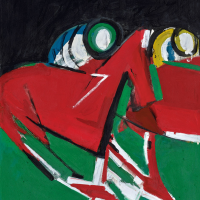11. GUY GREY-SMITH

Guy Grey-Smith spent much of his life painting the landscapes of Western Australia, where he was born and raised. His practice was multidisciplinary, encompassing ceramics, woodcuts and serigraph prints. Together these media complemented his painting style. They reflected his material interest in the plasticity of paint, much like clay, and the reduction of forms integral to woodcut and serigraph printing. As a Royal Australian Air Force pilot and prisoner-of-war during World War II, Grey-Smith remained in England after the war before returning to Western Australia, allowing him the opportunity to enrol at Londons Chelsea School of Art in 1945. His teachers included Henry Moore (1898-1986) and Robert Medley (1905-1994), whose interest in semi-abstraction echo through Grey-Smiths work. Additionally, Bloomsbury artists Roger Fry (1866-1934) and Vanessa Bell (1879-1961) could be considered as indirect influences via their association with his teacher Medley.
The common denominator for these artists is unsurprisingly Paul Czanne (1839-1906). Grey-Smith utilises core principles innovated by Czanne, layering fields of impasto pigment to create optical depth rather than a conventional use of linear perspective or geometric space. Forms are constructed by flat overlapping planes and patches of Fauvist colour, condensing them into necessary shapes. Grey-Smiths semi-abstract approach allowed the artist to capture qualities of movement and sensation. By the 1960s, French painter Nicolas de Stal (1914-1955) became another key influence for Grey-Smith, encouraging further simplification of forms which were now verging on abstraction and a more limited colour range applied to the canvas with a palette knife.
Horse and Jockey 1970 depicts two racing jockeys in close competition. The painting demonstrates how speed and momentum can be conveyed through an economical balance of colour, contrast, and contour. Central to the composition are the galloping horses situated between two minimal fields of turf green and black. The contrast of colours and lack of horizon line thrust them into the foreground. The entanglement of speeding bodies and flailing limbs generate suspense, the jockeys reduced to aerodynamic outlines through resolute strokes of paint.
Footnotes:
1. Guy Grey-Smith, quoted in Thomas, L., In Search of a Whole Wall to Plaster, The Australian, 8 March 1969, p.18
Tim Marvin
Tim Marvin is an emerging curator and art historian based in Sydney. He has a Bachelor of Art Theory (Honours, First Class) from the University of New South Wales, and currently holds positions at Sullivan + Strumpf and Artspace, Sydney.